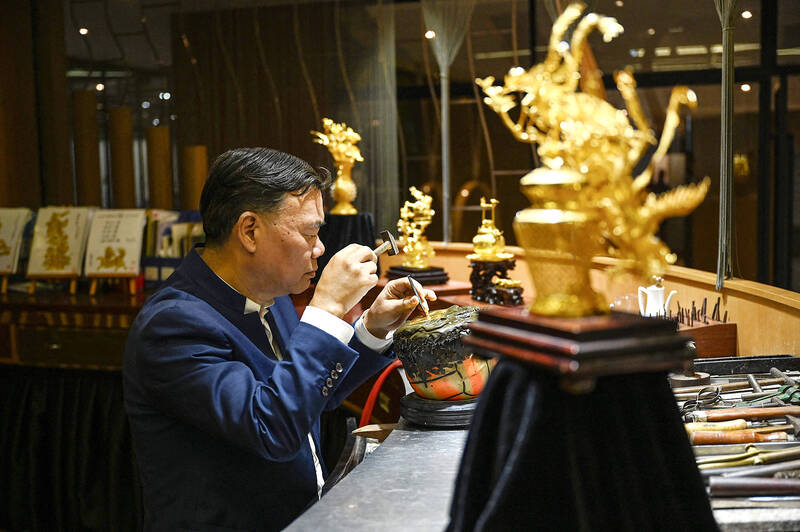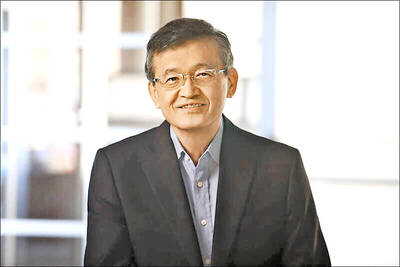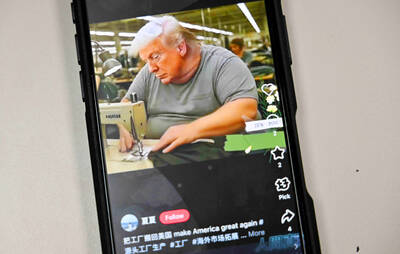The sound of gentle tapping filled a jewelry workshop in southern China as a craftsman hammered pine-leaf patterns onto a soft slab of gold in the style of old ink paintings.
Elaborate traditional pieces created by master goldsmiths have always been popular in China, bought as gifts for special occasions such as the Lunar New Year or simply as investments.
But jewelers are now having to consider a new and fast-growing consumer base — younger people, who are increasingly keen to buy gold, seeing it as a safe investment in uncertain economic times.

Photo: AFP
Key to gold’s popularity is China’s lackluster post-COVID-19 recovery, which is hitting young people especially hard as unemployment among young people soars and traditional investment options such as property suffer, analysts say.
“In the past, only the older generation would buy gold jewelry,” Chow Tai Fook Jewellery (周大福珠寶) master craftsman Tan Ruikun told reporters on a recent visit to the workshop in Guangdong Province.
“Young people are different now, they will also buy it because of its ability to retain value,” he said.
Sitting in cubicles and frowning with concentration, his colleagues twisted loops of gleaming metal into intricate patterns and peered through microscopes to add sparkling gems to gold pendants — the latter a style developed after feedback from younger customers.
“If younger elements are added in the design, it will appeal to young people even more,” Tan said.
In a bustling Shanghai jewelry market, 30-year-old freelancer Zhang Jie said that “it’s hard for young people to save money.”
Buying gold means “the money is still with you in a different way,” she said.
Millennials and Gen Z are “becoming a huge driving force” in the rising popularity of gold, Metals Focus founding partner Nikos Kavalis said. “The last few years have seen attitudes change dramatically.”
That reflects Chow Tai Fook’s recent consumer research, which suggested Gen Z was more attracted to buying gold than any other age group under the age of 40.
“Pure gold jewelry continues to serve as a safe haven for Chinese consumers amid recent economic conditions,” the report said.
Gold jewelry was among the best-performing consumer goods in China last year, as the post-pandemic recovery lost its shine in the face of flagging domestic consumption and declining business confidence. A long-running property sector crisis and more recent stock market rout have further dented investors’ options.
The jewelry market in central Shanghai was buzzing with customers before the Lunar New Year holiday.
Global gold prices hit a record high in December last year, so “people may see it as a more stable value of assets”, Zhang said.
Feng Ning, a 24-year-old medical industry worker, had similar motivations.
“When I started earning my own money... I bought other luxury products, but they would depreciate a lot when you want to exchange them for cash,” she said. “My friends [and I] have switched to choosing gold.”
One small shop in the labyrinthine market was notably busier than others, with almost every inch of its counters crowded.
The reason, said another store owner, was that it was famous on the social media platform Xiaohongshu — attracting younger customers.
Chow Tai Fook has also leveraged social media to adapt to this new interest, managing director Kent Wong said.
The 95-year-old company is keen to position itself as more than just a brand for the old, wealthy and traditional.
Typical jewelry pieces include enormous dangling necklaces made of nine descending pigs, a symbol of fertility given as part of wedding customs in southern China.
However, gold consumption in China last year was driven by “products lighter than 10 grams, or cheaper than 2,000 yuan” (US$281), the World Gold Council said, reflecting the smaller budgets of millennial and Gen Z customers.
Xiaohongshu users share videos of glass bottles full of gold beans or other charms, showcasing their savings as they add to their treasure pile.
Legacy jewelers have cabinets full of such golden amulets, but they also design bigger pieces aimed at young consumers.
A phenomenon noted by both the council and Wong was “guochao” — translated as “national wave” or “China chic” — the rise of brands that celebrate Chinese cultural identity.
“Young people are becoming more and more confident about Chinese culture,” Wong said.
The company recently ran a popular series that reimagined Tang dynasty museum pieces as modern jewelry.
“This is giving new life through our current aesthetics,” Wong said. “I think this is how to pass on our traditional things.”

Intel Corp chief executive officer Lip-Bu Tan (陳立武) is expected to meet with Taiwanese suppliers next month in conjunction with the opening of the Computex Taipei trade show, supply chain sources said on Monday. The visit, the first for Tan to Taiwan since assuming his new post last month, would be aimed at enhancing Intel’s ties with suppliers in Taiwan as he attempts to help turn around the struggling US chipmaker, the sources said. Tan is to hold a banquet to celebrate Intel’s 40-year presence in Taiwan before Computex opens on May 20 and invite dozens of Taiwanese suppliers to exchange views

Application-specific integrated circuit designer Faraday Technology Corp (智原) yesterday said that although revenue this quarter would decline 30 percent from last quarter, it retained its full-year forecast of revenue growth of 100 percent. The company attributed the quarterly drop to a slowdown in customers’ production of chips using Faraday’s advanced packaging technology. The company is still confident about its revenue growth this year, given its strong “design-win” — or the projects it won to help customers design their chips, Faraday president Steve Wang (王國雍) told an online earnings conference. “The design-win this year is better than we expected. We believe we will win

Chizuko Kimura has become the first female sushi chef in the world to win a Michelin star, fulfilling a promise she made to her dying husband to continue his legacy. The 54-year-old Japanese chef regained the Michelin star her late husband, Shunei Kimura, won three years ago for their Sushi Shunei restaurant in Paris. For Shunei Kimura, the star was a dream come true. However, the joy was short-lived. He died from cancer just three months later in June 2022. He was 65. The following year, the restaurant in the heart of Montmartre lost its star rating. Chizuko Kimura insisted that the new star is still down

While China’s leaders use their economic and political might to fight US President Donald Trump’s trade war “to the end,” its army of social media soldiers are embarking on a more humorous campaign online. Trump’s tariff blitz has seen Washington and Beijing impose eye-watering duties on imports from the other, fanning a standoff between the economic superpowers that has sparked global recession fears and sent markets into a tailspin. Trump says his policy is a response to years of being “ripped off” by other countries and aims to bring manufacturing to the US, forcing companies to employ US workers. However, China’s online warriors